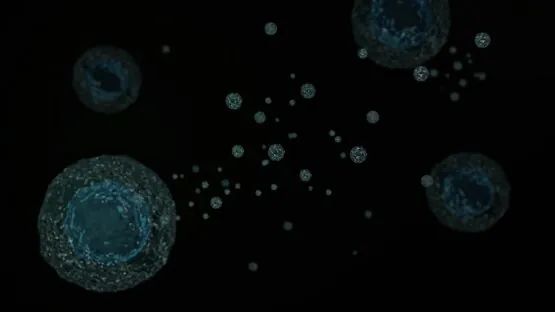Researchers have filled extracellular vesicles (EVs) with micro-RNA that is effective against liver fibrosis in mice and published their breakthrough in Aging Cell.
The cellular postal service
EVs, which cells use to send chemical messages and packages to one another, are significantly affected by aging to the point that they have been used as biomarkers [1] and even considered as a hallmark of aging themselves. Directly affecting these vesicles and using them as a therapeutic vector isn’t new to the research world; previous work has focused on using them to transmit NAMPT, which is part of the NAD+ synthesis process [2], and there is evidence that some stem cell therapies work predominantly through EVs, which have been well-documented as containing microRNAs (miRNAs) [3].
These researchers have previously documented potential benefits of certain miRNAs, including in human beings [4]. A previous experiment examining miRNAs carried in EVs found that they fought against senescence and significantly improved the mitochondrial function of mice, leading to improvements in metabolism [5].
These researchers, therefore, decided to create an experiment in which they would artificially add microRNAs to EVs to determine their effectiveness. As their target, they chose liver cells, as these cells’ senescence is strongly linked to a failure of liver function [6] as their mitochondria decline [7]. Mitochondrial dysfunction is also linked to insulin resistance [8].
Exercising has an effect on EVs
Initially, the researchers treated aged mice, which they confirmed to have increasing obesity and insulin resistance, with EVs derived from the serum of young mice. They noticed that it is difficult to purify EVs, as albumin is difficult to remove, and its apolipoproteins can carry microRNAs as well. Interestingly, if the younger mice were exercised beforehand, their EVs (EV-EX) were actually less effective in increasing insulin sensitivity when administered to older animals.
However, EV-EX stimulated different gene expression in a way that encourages better mitochondrial function, glucose handling, and fat burning, including improved triglyceride levels. Most importantly for this study, EV-EX stimulated a gene associated with better insulin handling in the liver, and they did not have negative effects on liver fibrosis in the way that EVs derived from sedentary young mice (EV-C) or EVs derived from aged mice (EV-A) did. These findings were confirmed by gene expression analysis showing that EV-A caused the upregulation of multiple fibrosis-related proteins that EVs from younger animals did not.
Taken together, while both EV-C and EV-EX can induce liver fibrosis regression, they might trigger different mechanisms.
A signal in the noise
The researchers found that six miRNAs were upregulated, and three were downregulated, in EV-EX compared to EV-A. Some differences in EV-C compared to EV-A were found, but they did not reach statistical significance. One specific miRNA, miR-30c-5p, was found to have a substantial number of downstream pathway targets that are known to have beneficial effects against fibrosis; EV-C and EV-EX were found to trend towards having more of this miRNA than EV-A.
The researchers then altered EV-A by replacing its contents with miR-30c-5p or a control (EV-SCR) and injected it once a week for four weeks. This treatment did not affect insulin sensitivity, glucose, body weight, or body composition. However, it had a significant and dramatic effect on liver fibrosis.

This effect was linked to a dramatic and direct decrease in Foxo3; other proteins associated with Foxo3‘s transcription and regulation were not affected.
While many of the other parts of this study had questionable and murky results, it has clearly demonstrated the potential of EVs as a treatment. As always, trials in humans need to be conducted before such modified EVs could be administered in the clinic.
Literature
[1] Kern, F., Kuhn, T., Ludwig, N., Simon, M., Gröger, L., Fabis, N., … & Keller, A. (2023). Ageing-associated small RNA cargo of extracellular vesicles. RNA biology, 20(1), 482-494.
[2] Yoshida, M., Satoh, A., Lin, J. B., Mills, K. F., Sasaki, Y. O., Rensing, N., … & Imai, S. I. (2019). Extracellular vesicle-contained eNAMPT delays aging and extends lifespan in mice. Cell metabolism, 30(2), 329-342.
[3] Chitti, S. V., Gummadi, S., Kang, T., Shahi, S., Marzan, A. L., Nedeva, C., … & Mathivanan, S. (2024). Vesiclepedia 2024: an extracellular vesicles and extracellular particles repository. Nucleic Acids Research, 52(D1), D1694-D1698.
[4] Smith-Vikos, T., Liu, Z., Parsons, C., Gorospe, M., Ferrucci, L., Gill, T. M., & Slack, F. J. (2016). A serum miRNA profile of human longevity: findings from the Baltimore Longitudinal Study of Aging (BLSA). Aging (Albany NY), 8(11), 2971.
[5] Chen, X., Luo, Y., Zhu, Q., Zhang, J., Huang, H., Kan, Y., … & Chen, X. (2024). Small extracellular vesicles from young plasma reverse age-related functional declines by improving mitochondrial energy metabolism. Nature Aging, 1-25.
[6] Aravinthan, A. D., & Alexander, G. J. (2016). Senescence in chronic liver disease: Is the future in aging?. Journal of hepatology, 65(4), 825-834.
[7] Ogrodnik, M., Miwa, S., Tchkonia, T., Tiniakos, D., Wilson, C. L., Lahat, A., … & Jurk, D. (2017). Cellular senescence drives age-dependent hepatic steatosis. Nat Commun 8: 15691.
[8] Kubota, T., Kubota, N., & Kadowaki, T. (2017). Imbalanced insulin actions in obesity and type 2 diabetes: key mouse models of insulin signaling pathway. Cell metabolism, 25(4), 797-810.




